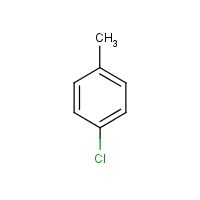4-Chlorotoluene
Agent Name
4-Chlorotoluene
CAS Number
106-43-4
Formula
C7-H7-Cl
Major Category
Solvents

Synonyms
1-Chloro-4-methylbenzene; 1-Methyl-4-chlorobenzene; 4-Chloro-1-methylbenzene; Benzene, 1-chloro-4-methyl-; Toluene, p-chloro-; p-Chlorotoluene; p-Tolyl chloride; [ChemIDplus] UN2238
Category
Chlorinated Aromatics
Description
Colorless liquid; [Hawley] Colorless liquid; mp = 7-9 deg C; [MSDSonline]
Sources/Uses
Used as a solvent and intermediate for dyes and other organic chemicals; [Hawley] As of 2005, used only as intermediate for other organic compounds; [eChemPortal: SIDSUNEP]
Comments
Defats the skin; [ICSC] Histopathological effects to liver (centrilobular hepatocellular hypertrophy), kidney (exacerbation of chronic progressive nephropathy), and adrenal cortex (adrenal cortical hyperplasia) were observed in 90 day feeding study with rats at the highest dose (800 mg/kg); Not mutagenic in Ames salmonella/microsome assay; [HSDB] A very mild skin and eye irritant, based on animal studies; [CHEMINFO] Rapidly absorbed by GI and respiratory tract, with limited absorption through the skin; Primarily excreted through urine; Mildly irritating to skin and eyes of rabbits; A skin sensitizer in the guinea pig maximization test; Effects in high single oral doses with rats include body tremor, decreased motor activity, and cyanosis; Histopathological findings limited to signs of irritation in the GI and respiratory tracts (severity increasing with dosage); Liver and kidney shown to be target organs of toxicity based on 29 and 90 day feeding studies with rats; No effects observed to reproductive organs; No evidence of mutagenicity; May be teratogenic at doses maternally toxic based on limited evidence from studies with the o-isomer; [eChemPortal: SIDSUNEP]
Biomedical References
Exposure Assessment
Vapor Pressure
2.69 mm Hg
Odor Threshold Low
0.05 ppm
Lethal Concentration
LC50 (mice) = 34,000 mg/m3/2h
Explanatory Notes
Flash point = 49 deg C; [ICSC] Odor threshold from CHEMINFO; The Guide in the Emergency Response Guidebook is for "Chlorotoluenes." VP from ChemIDplus;
NFPA
high ambient temp required
Adverse Effects
Neurotoxin
Acute solvent syndrome
Hepatotoxin
Hepatoxic (a) from occupational exposure (secondary effect) or (b) in animal studies or in humans after ingestion
Diseases, Processes, and Activities Linked to This Agent
Diseases
Occupational diseases associated with exposure to this agent: